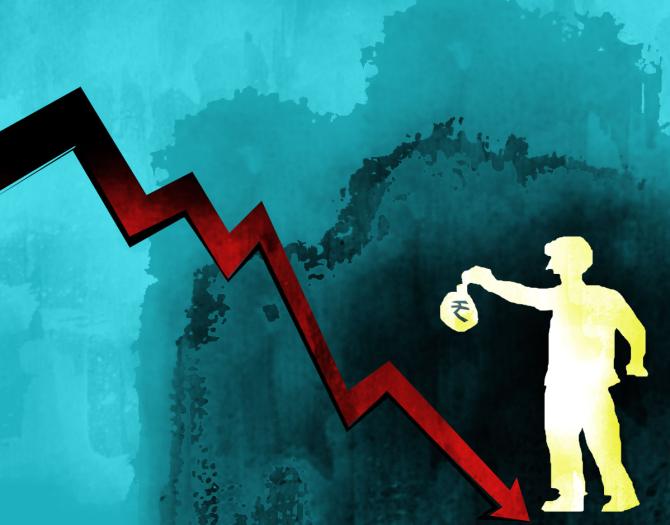Corporate margins and profits in India remain vulnerable to changes in crude oil prices in the international market.

Historical quarterly data from listed companies (excluding banks, finance and insurance, oil and gas, and power sectors) indicate an adverse correlation between corporate margins and crude oil prices.
An increase in companies’ core operating margins was observed in 2020-21 (FY21) following a sharp decline in crude oil prices in the first half of calendar year 2020 after the outbreak of the pandemic.
For instance, operating margins reached a record high of 20.3 per cent of net sales in the October-December quarter of FY21 as oil prices dropped to a record low of $33.7 in the April-June quarter (Q1) of FY21 from $66.4 a year ago.
However, margin gains for companies were reversed in 2021-22 (FY22) and the early part of 2022-23 (FY23) as Brent crude oil surged to a record high of $113.8 per barrel in Q1FY23.

This rally was fuelled by post-pandemic economic recovery worldwide and supply-chain disruptions caused by the Russia-Ukraine conflict.
Elevated energy prices led to increased operating costs for Indian companies, resulting in a decline in corporate margins to 15.5 per cent of net sales in the July-September quarter of FY22 quarter from 19.6 per cent a year ago.
This cycle reversed again in FY23 as crude oil prices declined, boosting corporate margins.
This cycle is once again swinging, with Brent crude oil up nearly 18 per cent since the end of December 2023.
As in the past, the rise in crude oil prices has been accompanied by an increase in industrial commodity prices as well.
For instance, the London Metal Exchange, which tracks prices of industrial metals like copper, aluminium, zinc, and lead, is up 10 per cent year-to-date.
This is likely to result in higher manufacturing costs for Indian companies, with a lag of four to six months.
“In the past two/three quarters, gains in corporate profits largely resulted from a decline in energy and commodity prices, while revenue growth was in low single digits.
"These gains are likely to reverse in forthcoming quarters if the recent rally in crude and commodity prices sustains,” says Dhananjay Sinha, co-head of equities and head of research at Systematix Group.
Here are the 12 companies from the BSE 500 universe that could experience significant impact from a rise in crude oil prices.
The analysis excludes oil and gas, power producers, and gems and jewellery companies.
Cement companies

- The numbers suggest that cement makers are among the most vulnerable to a rise in crude oil prices
- Analysts attribute this to the high usage of petroleum coke — a by-product of crude oil refining — in cement production in India, besides the high cost of transporting cement from factories to consumption centres
- In the past, a rise in crude oil prices has translated into higher power and fuel costs as well as transport and distribution expenses — two of the biggest operating expenses for cement makers
- This results in a decline in core operating profit margin (OPM) for cement producers leading to lower net profit
- Among the top listed cement makers, South-based India Cements seems to be the most vulnerable to higher crude oil prices, followed by Shree Cement, UltraTech, and Ambuja Cements
- India Cements’ core OPM turned negative in 2022-23 (FY23) from 19.2 per cent of net sales in 2020-21 as crude oil prices surged from $45.5 per barrel on average to $95.3 in FY23
- In the same period, UltraTech’s OPM was down to 16 per cent from 26.3 per cent, while Ambuja and Shree Cement also reported a decline in margins in the period
- Conversely, cement makers reported margin expansion in the first nine months of 2023-24 as crude oil prices were down 17 per cent
- The recent rise in crude oil price is expected to again put pressure on cement companies’ margins in 2024-25
Atul

- The majority of raw materials of Atul are derivatives of crude oil, and therefore, the prices of its raw materials vary with the fluctuation in international crude oil prices
- Atul’s raw material to sales has consistently risen since 2020-21 and is up 700 basis points (bps) since then to nine months of 2023-24he rise in all key cost heads has led to a 900-bp fall in operating profit margin over this period
- After a muted show in the October-December quarter, Anand Rathi Research is cautious regarding the company’s short-term performance, considering larger channel stocks globally of crop protection products
- While other segments could see a pickup on demand revival, the company is focusing on retail, backward integration, product launches, and widening its market reach, which would support growth in coming years, says the brokerage
Balkrishna Industries

- About 72 per cent of all costs for a tyre company are accounted for by raw materials.
- Within this, crude oil derivatives account for 55 per cent of costs
- For Balkrishna Industries, raw material cost as a proportion of sales was at 50 per cent and came down by about 200 basis points for nine months of 2023-24 (9MFY24)
- In addition to rising crude oil prices, higher natural rubber prices too will weigh on margins for the tyre exporter
- Core operating profit margin has dropped by 11 percentage points over 2020-21 through 2022-23 before recovering in 9MFY24
- The uptick in freight cost due to the Red Sea crisis remains an incremental headwind for the company as 45 per cent of volumes are derived from the European Union, says Kotak Securities
Exide Industry

- Lead-acid storage battery maker Exide Industries’ operating profit margin (OPM) and profits also show high sensitivity to the changes in crude oil prices
- Changes in crude oil prices largely affect Exide’s raw material costs — its biggest operating expenses besides the power and fuel costs
- The company’s raw material cost as a proportion of net sales increased to 70.7 per cent of net sales in 2022-23 (FY23) from 64.6 per cent in 2020-21 (FY21).
- Crude prices more than doubled in this period. The company also reported a rise in power and fuel and freight costs in the period further affecting its margins
- Exide’s core OPM declined to 8.5 per cent of net sales in FY23 from 13.2 per cent of net sales in FY21 as operating expenses grew faster than revenue
- In contrast, Exide’s operating expenses declined, and its OPM improved in nine months of 2023-24, thanks to gains from moderation in crude oil prices
- Given this, the recent rise in crude oil price raises the risk of a margin decline for Exide in 2024-25
HEG

- Graphite electrode manufacturer HEG’s operating profit margin (OPM) and profitability also show high sensitivity to changes in crude oil prices
- HEG’s core OPM halved between 2020-21 (FY21) and 2022-23 (FY23) as the average price of Brent crude oil more than doubled in the period from $45.5 to $95.3
- The company’s margin has again expanded in the first nine months of 2023-24 (9MFY24) as crude oil prices cooled down
- Changes in crude oil prices affect HEG’s margins through raw material and power and fuel costs
- For example, HEG’s raw material cost as a proportion of net sales increased to 53.2 per cent in FY23 from 40.2 per cent in FY21.
- The ratio again declined in 9MFY24 as crude oil prices moderated
- Analysts attribute this to the usage of petroleum coke as the basic raw material for the manufacture of graphite electrodes
Interglobe Aviation

- Aviation turbine fuel (ATF), a crude oil derivative, is by far the biggest cost head for aviation companies.
- It accounted for 40 per cent of InterGlobe’s (operator of IndiGo airline) costs and 35 per cent of its sales for the October-December quarter
- Power/fuel costs were at 43 per cent of sales in 2022-23 (FY23) and are up 17 percentage points over 2020-21. It is at 35 per cent for nine months of 2023-24 (9MFY24)
- Despite higher fuel costs, operating profit margins have doubled in 9MFY24 over FY23 as a sharp recovery in demand led by a resumption in corporate activity and revenge travel and better operating leverage improved operational performance
- Thus, revenue was up 30 per cent year-on-year in Q3, while costs were up 22 per cent on the back of higher yields and occupancies, while lower ATF prices helped keep overall costs in check
- Although rising crude oil price is a worry, a duopoly-like situation, a long growth runway, aggressive network expansion, and steps to reduce non-fuel bills are keeping brokerages positive on the market leader
Kajaria Ceramics

- Power and fuel costs have jumped 10 percentage points as a proportion of sales for the country’s largest listed tile maker
- Given the direct correlation between gas prices and the profitability of Kajaria Ceramics, margins have dropped by half for the company between 2020-21 and 2022-23 amid sluggish demand
- While lower gas prices in third quarter (as also fourth quarter) were positive, the issue for the company is weak demand which forces it to pass on some of the cost savings as discounts to boost volumes. Any sharp rise in gas costs remains a key worry
- Strong demand from real estate and the government’s infrastructure push, steady exports from the Morbi cluster, the company’s distribution push, and brand pull are expected to keep volumes strong going ahead
MRF

- With the share of raw material to net sales rising by 13 percentage points over 2020-21 through 2022-23, the operating profit margin more than halved in this period before recovering sharply in the nine months of 2023-24. Rising crude oil and natural rubber prices, however, are likely to aggravate the situation going ahead
- Domestic demand trends for some replacement segments over the past three quarters are lower than expected which, coupled with sluggish average selling prices due to the pass-through of lower raw material costs, have weighed on revenue growth
- The company’s competitive positioning has weakened over the past few years, evident in the dilution of pricing power in the passenger and truck/bus radial segments
- This, coupled with the impact of the planned capital expenditure, is expected to constrain the expansion in return ratios, says Motilal Oswal Research
National Aluminium Company

- The government-owned primary aluminum producer National Aluminium Company (Nalco) is also likely to be impacted by a rise in crude oil price
- In the past, a rise in crude oil price has resulted in higher raw material and power and fuel costs for Nalco leading to lower operating profit margin (OPM) and profits
- Petroleum coke is a key ingredient in the production of aluminum, and its prices are directly linked to the price of crude oil
- Nalco’s raw material costs as a proportion of net sales increased to 22.3 per cent in 2022-23 (FY23) from 14.7 per cent as crude oil prices surged in the period. Similarly, its power and fuel costs increased to 33.2 per cent of net sales in FY23 from 29.84 per cent in 2020-21 (FY21)
- As a result, Nalco’s core OPM declined to 16.3 per cent of net sales in FY23 from 19.8 per cent of net sales in FY21
- In contrast, the company reported a moderation in its key operating cost and 160 basis points improvements in its core OPM in nine months of 2023-24, thanks to gains from lower crude oil prices
- The recent rise in crude oil price, however, threatens to reverse margin gains in 2024-25












 © 2025
© 2025